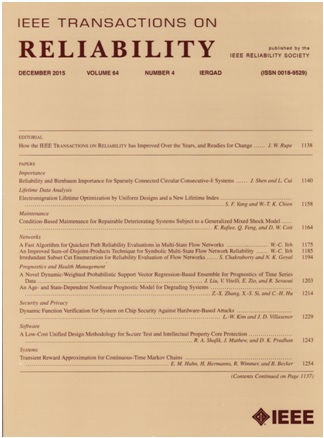基于递归神经网络的预测维护边缘人工智能在蠕动泵早期老化检测中的应用研究
IF 5.7
2区 计算机科学
Q1 COMPUTER SCIENCE, HARDWARE & ARCHITECTURE
引用次数: 0
摘要
蠕动泵广泛应用于许多工业应用,特别是在医疗设备中。它们的可靠性取决于适当的维护,其中包括由于材料老化而定期更换管道。正确使用预测性维护技术可以潜在地提高维护干预的效率,并通过确定管柱何时超过更换时间来防止故障。我们使用六个不同的传感器(三个加速度计,一个陀螺仪,一个磁力计和一个麦克风)使用几个磁带(三个新单元和三个寿命过期的单元)记录了一个数据集。记录在尽可能高的频率下完成(100-6667 Hz,每个传感器不同),然后下采样几次以获得低至12 Hz的频率。这个数据集现在是公开的。我们训练了939个不同的模型,这些模型是将所有不同的传感器作为麦克风输入的结果,以及递归神经网络的四种基本架构:一层或两层门控递归单元或长短期记忆,每层有不同数量的节点(从2到64)。在所有训练的模型中,我们选择了10个在准确性和复杂性方面表现最好的网络。经交叉验证,F1值均达到0.99或1。这些模型部署在四种不同的边缘人工智能设备上。对于模型和边缘AI设备的所有组合,我们获得了内存大小(从0.3%到160.6% RAM,从0.9%到21.3%闪存),推理时间(从0.39到1463.91 ms)和平均消耗(从0.15到5.30 mA)的指标。十个模型中有九个被证明是可部署的。我们的结论是,基于磁力计数据的四种模型在消耗和推理时间方面明显更好。据我们所知,在预测性维护应用中,使用磁力计数据是一种非常不常见的故障检测方法,这可能是首次将其用于蠕动泵老化检测,因此我们的结果对未来的应用非常有希望。此外,由于大多数训练过的模型使用很少的资源,我们已经证明我们的方法与在同一设备上运行其他通信和控制算法完全兼容,这对于工业系统中的易于集成和可扩展性非常理想。实际部署的一些限制包括面临环境因素(噪音)和长期监测,因此我们还提出了一种协议,通过可控的方式进行测量来减少这些因素的影响。本文章由计算机程序翻译,如有差异,请以英文原文为准。
Predictive Maintenance Edge Artificial Intelligence Application Study Using Recurrent Neural Networks for Early Aging Detection in Peristaltic Pumps
Peristaltic pumps are widely used in many industrial applications, especially in medical devices. Their reliability depends on proper maintenance, which includes the total replacement of tubes regularly due to the aging of the materials. The proper use of predictive maintenance techniques could potentially improve the efficiency of maintenance interventions and prevent failures by having a way to determine when the tube has passed its replacement time. We recorded a dataset using six different sensors (three accelerometers, one gyroscope, one magnetometer, and one microphone) using several cassettes (three new units and three units with expired life span). The recording was done at the highest possible frequency (100–6667 Hz, different for each sensor) and then downsampled several times to obtain frequencies as low as 12 Hz. This dataset is now publicly available. We trained 939 different models, which were the result of combining all different sensors as inputs but the microphone, and four basic architectures of recurrent neural network: One or two layers of either gated recurrent unit or long short-term memory with different number of nodes per layer (from 2 to 64). Among all trained models, we selected the ten best performing networks in terms of both accuracy and complexity. All of them reached an F1 score of 0.99 or 1 with holdout cross-validation. Those models were deployed on four different edge AI devices. For all combinations of model and edge AI devices we obtained metrics of memory size (from 0.3% to 160.6% RAM, and from 0.9% to 21.3% flash), inference time (from 0.39 to 1463.91 ms), and average consumption (from 0.15 to 5.30 mA). Nine out of ten models were proven viable for deployment. We concluded that the four models based on magnetometer data were significantly better in terms of consumption and inference time. To the best of our knowledge, the use of magnetometer data is a very uncommon approach to failure detection in predictive maintenance applications, and this is probably the first time it has been used for peristaltic pump aging detection, so our results are very promising for future applications. Also, since most trained models use little resources, we have proved that our approach is perfectly compatible with running other communication and control algorithms on the same device, which is ideal for easy integration and scalability in industrial systems. Some limitations for real deployment include facing environmental factors (noise) and long-term monitoring, so we also proposed a protocol that should reduce the impact of those factors by taking measurements in a controlled way.
求助全文
通过发布文献求助,成功后即可免费获取论文全文。
去求助
来源期刊

IEEE Transactions on Reliability
工程技术-工程:电子与电气
CiteScore
12.20
自引率
8.50%
发文量
153
审稿时长
7.5 months
期刊介绍:
IEEE Transactions on Reliability is a refereed journal for the reliability and allied disciplines including, but not limited to, maintainability, physics of failure, life testing, prognostics, design and manufacture for reliability, reliability for systems of systems, network availability, mission success, warranty, safety, and various measures of effectiveness. Topics eligible for publication range from hardware to software, from materials to systems, from consumer and industrial devices to manufacturing plants, from individual items to networks, from techniques for making things better to ways of predicting and measuring behavior in the field. As an engineering subject that supports new and existing technologies, we constantly expand into new areas of the assurance sciences.
 求助内容:
求助内容: 应助结果提醒方式:
应助结果提醒方式:


